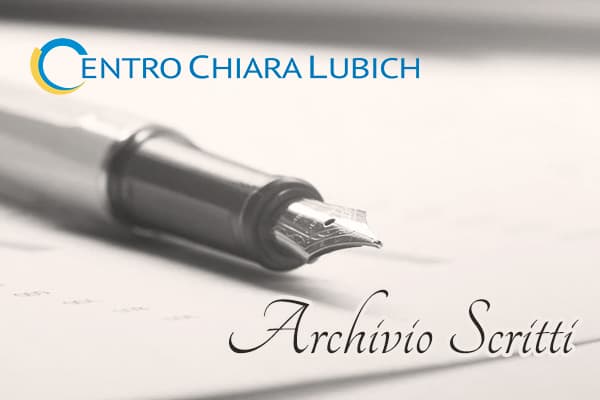Castel Gandolfo, December 8, 1996
Extract from a talk given by Chiara Lubich on the collective spirituality
To believe in the extraordinary grace of being able to imitate Mary. Chiara shares here the experience of light that the Holy Spirit gave her, conveying this conviction to us and suggesting we can honour her in this way.
…
As we briefly look over the history of the Focolare Movement with regard to Mary, we can see more clearly who Mary is for us, and how she can be considered as a cornerstone of our spirituality.
From the earliest days of the Focolare, although during that period of time it seemed that she was letting the Spirit highlight almost exclusively Jesus and his gospel, Mary appeared, although discreetly, in order to reveal to us at once her relationship with unity.
Some examples.
I wrote in 1947:
“I am convinced that it is she [Mary] who wants unity. She [Mary]: Mater unitatis! …
“She knows Satan, his promises, deceptions, and traps; and she calls her children to be united, to help one another as they journey along the way of love!”
Another letter from 1947:
“Our Lady wants us to be united in our journey! She knows that ‘where two or more’ are united in the holy name of her Son, he is in their midst! And where there is Jesus, dangers flee and obstacles disappear. … He overcomes everything because he is love!”
…
Later on she manifested herself to our soul in all her splendor. We saw that her greatness was in proportion to how much she had lowered herself, to how much she had annulled herself.
In 1949, while we were together in the mountains, it seemed that the Lord showed us the main lines of the Work of Mary that would come to life.
We understood that, through it, Mary wanted in some way to return on earth.
This perception was so strong that in admiring her unique beauty and thinking of her and seeing her almost alone – because we couldn’t find any children beside her worthy of such a mother, except for Jesus – we felt urged to ask her to bring about on earth a family of sons and daughters all like her.
Before that, we had asked Jesus in the Eucharist to entrust us, to “consecrate” us to Mary, as he knows how.
We had understood that this act had not been merely an expression of devotion empty of true content, but that this “consecration” had brought about something new.
It seemed to us that Mary had clothed us with her immaculateness.
It seemed as if we were experiencing in our small group what Montfort spoke about with regard to the interior wonders that Mary secretly works in souls: “The principal effect is that Mary comes to live in the soul so that it is no longer the soul that lives, but Mary who lives in the soul.”
Essentially, it seemed that what Paul VI had asked one day had become a reality. He prayed: “Teach us what we already know . . . to be immaculate as you are.”
We felt ourselves to be children of Mary and – in a way that we will never be able to forget – for the first time, we felt that Mary was our mother.
A few years later, the following well-known episode confirmed all this for us:
“I went into church one day, and with my heart full of trust, I asked: ‘Why did you wish to remain on earth, on every point of the earth, in the most sweet Eucharist, and you have not found – you who are God – also a way to bring and to leave Mary here, the mother of all of us who journey?’
“In the silence he seemed to reply: ‘I have not left her because I want to see her again in you.’”
To be another Mary, a little Mary; to find in our mother what we are called to be and in ourselves the possibility to be another her.
But to be mother as she is means being able to imitate her in her spiritual maternity (which becomes spiritual paternity for men), a maternity or paternity which forms the people entrusted to them, not only in order to make them beautiful and holy, but to unite them with God and with one another.
This is the way Mary is mother. She is Mater unitatis.
(Published in A New Way, pp. 68-70)
Video in Italian

